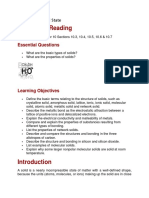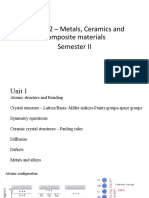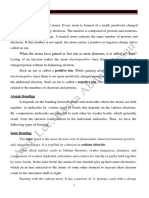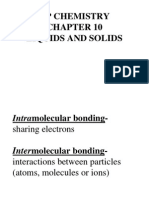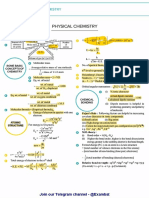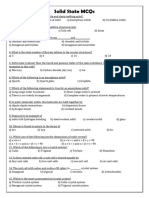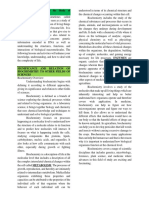Module 1 Structure of Materials
Uploaded by
Shin ChanModule 1 Structure of Materials
Uploaded by
Shin ChanMATERIAL SCIENCE & ENGINEERING 21ME33
MODULE 1- STRUCTURE OF MATERIALS
Introduction:
When we say ‘materials’ we think of nearly all materials known to science and in all
states of matter like solid, liquid & gaseous, but material science concern itself basically with
the nature & behaviour of only solid materials.
‘Solid engineering materials’ are those which helps engineers to build machines,
structures, automobiles, and air craft.
Classifications of engineering materials:
(i) Metals & alloys: Ex: cast iron, steels, aluminium, copper, silver, gold, brass
&bronge
(ii) Ceramics & glasses : Ex: MgO, ZnO, SiC, concrete & cement
(iii) Polymers: plastics, polyethylene, PVC, nylon, cotton & rubber
(iv) Composites: metal-matrix composites
Each of above group of materials has their own set of properties.
Mechanical: strength, hardness, ductility, malleability, toughness, resilience &
fatigue
Physical: shape, size, density, porosity & colour
Chemical: acidity, alkalinity, composition, corrosion resistance, atomic number &
molecular weight
Electrical: conductivity, resistivity, dielectric constant, dielectric strength & power
factor
Thermal: Specific heat, refractoriness & conductivity
Aesthetic: feel, texture, appearance, lustre
The above properties of the materials which guide us in the selection of the materials for
specific operations as listed below,
(i) An aircraft structure has to be built with materials having low density but high
strength.
(ii) A steel melting furnace has to be lined with refractory materials to with stand high
temperature.
(iii) Buildings & structures have to be built with materials having high compressive
strength to with stand heavy loads.
Dept., of Mech., Engg, SVIT, B’luru-64. Page 1
MATERIAL SCIENCE & ENGINEERING 21ME33
Crystalline and non-crystalline solids:
Non- Crystalline solids/
Crystalline solids amorphous solids
1. The basic structural unit is a crystal The basic structural unit is a molecule &
[a slid whose constituent molecules chains of these molecule come together to
or atoms are arranged in a form an amorphous solids
systematic geometric pattern.
2. Each crystal [also called as a grain] The chains of molecules are random within
is made up of a number of the solid & occur in no particular relation
respective blocks called unit cells[ to each other. They are irregular & lack
the smallest group of atoms symmetry
possessing the symmetry of the
crystal] which are arranged neatly
in relation to each other
3. Compare crystalline solid with a In this, crowd where people are random &
military parade where all soldiers not arranged in order with respect to each
are arranged in order with respect to other.
each other.
4. A crystalline solid therefore is made In this it is made up of millions of
up of millions of unit cells orderly molecules disorderly arranged
arranged. Each unit cell is itself
made up of atoms & the number of
atoms depends on the type of unit
cell.
5. Metals, alloys, some salts like NaCl, Glass, polymers, rubber & plastics
KCl, many oxides & ceramics, non
metals like diamond, Gem stones
6. Density of crystalline solids is Generally low because molecules cannot be
generally high. They have higher compacted. They have lower melting point
melting point & strength & strength
7. Structures are stable & materials are Structures are unstable & materials are less
stronger stronger
Aggregates: some materials are obtained both in crystal as well as amorphous. Ex: silicate
can occur as crystalline solid [quartz] or a Non- Crystalline solids/ amorphous solids [silicate
glass]. Aggregates type of materials which have short range order but no long-range order.
Ex: concrete, rocks & minerals.
Dept., of Mech., Engg, SVIT, B’luru-64. Page 2
MATERIAL SCIENCE & ENGINEERING 21ME33
Atomic bonding: In a substance atom of interact with each by forming bonds to create
molecules and macroscopic materials. There are three basic ways that the outer electrons of
atoms can form bonds:
Ionic bond -Electrons can be transferred from one atom to another
Covalent bond Electrons can be shared between neighbouring atoms
Metallic bond-Electrons can be shared with all atoms in a material
Secondary Bonding
Ionic bond: Ionic bonding forms between two oppositely-charged ions which are produced
by the transfer of electrons from one atom to another. Electropositive elements such as the
alkali metals have small ionization potentials. Electronegative elements such as halogens
have large electron affinities. Hence ionic bonds form most readily between electropositive
and electronegative elements.
Ex: Consider as an example an atom of sodium, which has one electron in its outermost orbit,
coming near an atom of chlorine, which has seven. Because it takes eight electrons to fill the
outermost shell of these atoms, the chlorine atom can be thought of as missing one electron.
The sodium atom donates its single valence electron to fill the hole in the chlorine shell,
forming a sodium chloride system at a lower total energy level.
The ionic bond is non-directional because the electron transfer results in the inert gas
configuration around both the nuclei and has spherical symmetry of the electron probability
cloud. Therefore, the bonding force between the ions is the same in all directions.
Covalent bond: Covalent bonding occurs by the sharing of electrons between neighbouring
atoms. In order for covalent bond to be realised there must be net decrease in potential
energy, and good overlap of the orbitals, to bring the shared electrons close to both the nuclei,
is necessary. To do this there must be vacant electron states in the outermost orbital of the
bonding atoms. As the overlapping orbitals are directionally oriented covalent bond are
directional.
Ex: Consider first the formation of a hydrogen molecule. When two hydrogen atoms are very
far apart, they do not interact, and the lone electrons of the atoms stay in their respective 1s
ground states. When the atoms come closer, the electron probability clouds of the 1s states
overlap. As the 1s orbitals can have two electrons of opposite spin, the sharing of electrons
between the two atoms takes place, without having to promote the electrons to higher energy
levels. Both the electrons are close to both the nuclei and, in fact, spend much of the time in
between the two nuclei. Covalent bonds are particularly common in organic materials, where
molecules often contain long chains of carbon atoms
Metallic bond: In metallic bonding the sharing of electrons between neighbouring atoms
now becomes delocalised as there are not enough electrons to produce the inert
gas configuration around each atom. The metallic sharing changes with time and
the bonding electrons resonate between different atoms. The metallic state can
Dept., of Mech., Engg, SVIT, B’luru-64. Page 3
MATERIAL SCIENCE & ENGINEERING 21ME33
be visualized as an array of positive ions, with a common pool of electrons to
which all the metal atoms have contributed their outer electrons. This common
pool is called the free electron cloud or the free electron gas. These electrons
have freedom to move anywhere within the crystal and act like an all-pervasive,
mobile glue holding the ion cores together. The electron freedom in metallic bonding makes
the metallic bonds non-directional.
Ex: Cu, Ag etc.
Secondary Bonding
Hydrogen Bond: In many molecules, where hydrogen takes part in the covalent bonding, the
centres of the positive and the negative charges do not coincide. Consider the
example of the water molecule. The electronegativity of oxygen is 3.5 and that of
hydrogen is 2.1. Therefore, the oxygen atom pulls the bonding electrons to itself
more strongly than hydrogen does. This results in a net negative charge at the
oxygen end and a net positive charge at the hydrogen end of the molecule. Due to
this imbalance in electrical charge, the water molecule possesses a permanent
dipole moment. The bond that is formed between water molecules due to attraction
between the positively-charged hydrogen end of a molecule and the negativelycharged
oxygen end of another molecule is called the hydrogen bond.
van der Waals:Inert gas atoms have spherically symmetric electron probability clouds
around them and, therefore, have no permanent dipole moments. Yet, inert gases
form solid crystals at sufficiently low temperatures. The bonding in such solids
is called the van der Waals bonding. It is the result of momentary fluctuations in
the charge distribution around an atom.
Geometrical Crystallography
Symmetry elements:
An object is described as symmetric with respect to a transformation if the object appears to
be in a state that is identical to its initial state, after the transformation. In crystallography,
most types of symmetry can be described in terms of an apparent movement of the object
such as some type of rotation or translation. The apparent movement is called the symmetry
operation. The locations where the symmetry operations occur such as a rotation axis, a
mirror plane, an inversion center, or a translation vector are described as symmetry elements.
The operation of rotation
The rotation operations (both proper and improper) occur with respect to a line called rotation
axis.
A proper rotation is performed by rotating the object 360°/n, where n is the order of the axis.
The resulting rotated object is always indistinguishable from the original.Crystals with a
periodic lattice can only have axes with 1-, 2-, 3-, 4-, and 6-fold symmetry axes.
1-Fold Rotation. A 1(E)-fold rotation operation implies either a 0° rotation or a 360°
rotation, and is referred to as the identity operation
Dept., of Mech., Engg, SVIT, B’luru-64. Page 4
MATERIAL SCIENCE & ENGINEERING 21ME33
(Figure for understanding only)
2-Fold Rotation. A 2-fold(C2) rotation operation moves the object by (360/2) ° = 180 °. The
symbol used to designate a 2-fold axis is a solid oval.
(Only for understanding)
3-Fold Rotation. A 3-fold(C3) rotation operation moves the object by (360/3) ° = 120 °. The
symbol used to designate a 3-fold axis is a solid equilateral triangle
(Only for understanding)
4-Fold Rotation. A 4-fold(C4) rotation operation moves the object by (360/4) ° = 90 °. The
symbol used to designate a 4-fold axis is a solid square.
(Only for understanding)
6-Fold Rotation. A 6-fold(C6) rotation operation moves the object by (360/6) ° = 60 °. The
symbol used to designate a 6-fold axis is a solid hexagon.
Dept., of Mech., Engg, SVIT, B’luru-64. Page 5
MATERIAL SCIENCE & ENGINEERING 21ME33
(Only for understanding)
Improper Rotations
An improper rotation may be thought of as occurring in two parts, first a proper rotation is
performed, followed by an inversion through a particular point on the rotation axis.
In the H-M (Hermann–Mauguin) nomenclature, improper rotations are sometimes called
roto-inversions. In the Schönflies scheme, improper rotations are roto-reflection axes because
they are a rotation followed by a reflection perpendicular to the rotation axis.
Improper rotations are designated by the symbol n, where n represents the type of proper
rotation component of the operation. As in the proper rotation operations,
only 1 (i = S2), m = 2 (σ = S1), 3 (S6), 4 (S4), and 6 (S3) improper rotations are commonly
observed in crystals. These axes are pronounced as 3 bar in the United States and bar 3 in
many European countries. Thus 3 in H-M is equivalent to S6 in Schönflies.
Note that it is not necessary for either the rotation operation or the inversion center to exist as
an operation of the group for the improper rotation axis to exist, e.g. the 4 (S4) operation
contains neither a 4-fold rotation axis (C4) nor an inversion center.
3 Roto-inversion. This operation involves a rotation by (360/3) ° followed by an
inversion through the center of the object. The symbol is a filled triangle with an open
circle in the middle. This is the only improper rotation that also includes the proper
rotation axis and an inversion center.
4 Roto-inversion. This operation involves a rotation by (360/4) ° followed by an
inversion through the center of the object. The symbol is an open 4-sided diamond
with an filled oval in the middle.
6 Roto-inversion. This operation involves a rotation by (360/6) ° followed by an
inversion through the center of the object. The symbol is an open hexagon with an
filled triangle inside.
Screw axes, and Glide planes
Combining the rotation axes and the mirror planes with the characteristic translations of the
crystals (which are shown below), new symmetry elements appear, with some "sliding"
components: screw axes (or helicoidal axes) and glide planes.
Dept., of Mech., Engg, SVIT, B’luru-64. Page 6
MATERIAL SCIENCE & ENGINEERING 21ME33
Twofold screw axis. A screw axis consists of a rotation followed by a translation
Twofold screw axis applied to a left hand. The hand rotates 180º and moves a half of the lattice
translation in the direction of the screw axis, and so on. Note that the hand always remains as a left
hand.
(Animation taken from M. Kastner, T. Medlock & K. Brown, Univ. of Bucknell)
Dept., of Mech., Engg, SVIT, B’luru-64. Page 7
MATERIAL SCIENCE & ENGINEERING 21ME33
Glide plane. A glide plane consists of a reflection followed by a translation
Glide planeapplied to a left hand. The left hand reflects on the plane, generating a right hand that
moves a half of the lattice translation in the direction of the glide operation.
(Animation taken from M. Kastner, T. Medlock & K. Brown, Univ. of Bucknell)
Crystal Structure
Refers to the manner in which atoms, ions, or molecules are spatially arranged
Space lattice is defined as an infinite array of points in three dimensionsin which every point
has surroundings identical to that of every other point inthe array
Unit cell: it is the smallest repeatable unit of a crystalline solid. In other words every unit cell
is a crystalline solid consists of a group of atoms arranged in a definite order.
Dept., of Mech., Engg, SVIT, B’luru-64. Page 8
MATERIAL SCIENCE & ENGINEERING 21ME33
Crystal Lattice: crystal lattice is the symmetrical three-dimensional structural arrangements
of atoms, ions or molecules (constituent particle) inside a crystalline solid as points.
Planes and directions in a lattice:
Crystal directions are obtained using the system devised by Miller. Consider the figure below
the vector r, passing through the origin o to a lattice point, can be expressed in terms of the
fundamental translation vectors a, b and c, which form the crystal axes, as r = rla+ r2b + r3c.
where r1, r2 and r3 are integers. The c-axis is not shown in the figure as r is assumed to lie on
the ab plane. The components of r along the three axes are: r 1 = 2, r2 = 3 and r3 = 0. Then the
crystal direction denoted by r is written as [230] in the Miller notation, with square brackets
enclosing the indices.
Figure: The Miller indices of the crystal direction denoted by vector rare [230]
If there is a negative component along a crystal axis such as –2, it is writtenas 2 and read as
bar 2. A family of directions is obtained by all possiblecombinations of the indices, both
positive and negative. The family [230], [203],[203], [302], [320], etc., is represented by
<230>, where the angular brackets<> denote the entire family.
The crystal directions [230], [460] and [1 1½ 0] all have the same direction, but different
magnitudes. Since Miller indices for directions are usually specified as the smallest possible
integers, the differences in magnitude for the above three directions are indicated using the
following convention: [230], 2[230] and 1/2[230]
The Miller indices of a crystal plane are determined as follows. Referring to theplane shown:
Dept., of Mech., Engg, SVIT, B’luru-64. Page 9
MATERIAL SCIENCE & ENGINEERING 21ME33
A crystal plane making intercepts 2, 3 and 1 on the crystal axes a, b
and c. Its Miller indices are (326).
The factor that results in converting the reciprocals to integers may be indicatedoutside the
brackets, but it is usually omitted. The family of planes withmembers (236), (263), (362),
(326), (632); etc., is denoted by {326}, thecurly brackets { } standing for the family.
Planar Atomic Density
planar density (PD) is taken as the number of atoms perunit area that are cantered on a
particular crystallographic plane.
The units for planar density are reciprocal area (e.g., nm−2, m−2)
(a) Reduced-sphere FCC unit cell with the (110) plane. (b) Atomic packing of an FCC (110)
plane.Corresponding atom positions from (a) are indicated
Consider the section of a (110) plane within an FCC unit cell. Although six atoms have
centers that lie on thisplane (Figureb), only one-quarter of each of atoms A, C, D, and F and
one-half ofatoms B and E, for a total equivalence of just 2 atoms, are on that
plane.Furthermore,the area of this rectangular section is equal to the product of its length and
width. FromFigure b, the length (horizontal dimension) is equal to 4R, whereas the width
(vertical dimension) is equal to 2R√2 because it corresponds to the FCC unit cell edge length
(Equation 3.1). Thus, the area of this planar region is (4R)(2R√2) = 8R2√2, and theplanar
density is determined as follows:
Dept., of Mech., Engg, SVIT, B’luru-64. Page 10
MATERIAL SCIENCE & ENGINEERING 21ME33
1
𝑃𝐷110 (𝐹𝐶𝐶 ) =
4𝑅2 √2
Atomic packing factor:
It is the ratio of the volume of atoms contained in each unit cell to the volume of the unit cell itself
OR the APF represents the percentage of space within each unit cell of a crystal structure which is
packed with atoms.
It also gives us information on the free space available within the unit cell.
APF basically affects the density of the material.
𝑽𝒐𝒍𝒖𝒎𝒆 𝒐𝒇 𝒂𝒕𝒐𝒎𝒔
APF =
𝐕𝐨𝐥𝐮𝐦𝐞 𝐨𝐟 𝐮𝐧𝐢𝐭 𝐜𝐞𝐥𝐥
APF of SC-0.52
APF of BCC-0.68
APF of FCC and HCP-0.74
Packing of atoms
FCC and HCP may be described in terms of stacking of the atoms in the close-packed planes
of atoms. A portion of one such plane is illustrated in Figure a below. The two crystal
structures may be generated by the stacking of these close-packed planeson top of one
another; depending on the stackingsequence.
Figure: (a) A portion of a close-packed plane of atoms; A, B, and C positions are indicated.
(b) The ABstacking sequence for close-packed atomic planes.
In the Figure athe sites having the triangle vertex pointing up are arbitrarily designated as B
positions, whereasthe remaining depressions are those with the down vertices, which are
marked C. A second close-packed plane may be positioned with the centers of its atoms
overeither B or C sites; at this point both are equivalent. Suppose that the B positions
arearbitrarily chosen; the stacking sequence is termed AB, as shown in Figure b. This
stacking sequence, ABABAB.. results in HCP. In the FCC case the after the B positions,
atoms occupy C position then the sequence will be ABCABCABC. .
Classification and Coordination of voids
What are Voids?
In close packing of spheres, some hollows or voids are left blank. These vacancies in the
crystal are called interstitial Voids or interstitial sites or simply, voids. The two essential
interstitial voids are Tetrahedral Voids and Octahedral Voids.
Dept., of Mech., Engg, SVIT, B’luru-64. Page 11
MATERIAL SCIENCE & ENGINEERING 21ME33
Packing of spheres consisting of two types of blanks after arranging the two layers. The void
is formed by four spheres is called tetrahedral void, and the void formed by the six spheres is
called the octahedral void.
Tetrahedral voids
A sphere in the second layer is placed on top of three spheres touching each other in the first
layer. The centres of these spheres lie at the top of a tetrahedron. It is likely that the shape of
the void is not tetrahedral, but that the arrangement around this void is tetrahedral. The
space between four spheres having a tetrahedral arrangement is called a tetrahedral void or a
tetrahedral space. A crystal has two tetrahedral voids per atom.
The number of Tetrahedral Voids in a lattice can be easily calculated. The number of voids
will be twice as much as the number of spheres (i.e. unit cells) in this case. As a result, there
will be “2n” tetrahedral voids.
Tetrahedral voids
Ex: in the FCC unit cell, the centres of the tetrahedral voids lie quarter-wayand three-quarter-
way along the four nonparallel body diagonals of the cube.There are thus eight tetrahedral
voids in the unit cell
Octahedral void
The octahedral space is a type of space or void that forms at the centre of six circles. It is
visible in the diagram that each octahedral void is formed by the combination of triangular
voids of the first and second layers. The void formed by the vertices on opposite sides by two
equilateral triangles is called octahedron al void or octahedral site. Therefore, this void is
surrounded by 6 spheres at the vertices of a regular octahedral. A crystal has one octahedral
void per atom.
As a result, an octahedral void is formed when the first layer’s tetrahedral void and the
second layer’s tetrahedral void align. A void forms in the centre of six spheres here. So an
octahedral void has a coordination number of six.
If the number of spheres in a structure is “n,” the number of octahedral voids will be the
same. “n” is a good example.
Dept., of Mech., Engg, SVIT, B’luru-64. Page 12
MATERIAL SCIENCE & ENGINEERING 21ME33
Octahedral void
Ex: in the FCC unit cell, the centres of the octahedral voids fallat the body centre and at the
middle of the 12 cube edges. The effective numberof octahedral voids per unit cell is then 1 +
12 1/4 = 4. This is equal to theeffective number of atoms in the unit cell.
Difference between tetrahedral and octahedral voids
Tetrahedral voids Octahedral voids
Tetrahedral voids are unoccupied empty Octahedral voids are unoccupied
spaces present in substances having a empty spaces present in substances
tetrahedral crystal system. having an octahedral crystal system.
It can be found in substances having
It can be found in substances having a
an octahedral arrangement in their
tetrahedral arrangement in their crystal system.
crystal system
Tetrahedral voids can be observed in the edges Octahedral voids can be observed in
of the unit cell. the center of the unit cell.
Four is the coordination number of the Six is the coordination number of the
tetrahedral void. Octahedral void.
In the space lattice, there are two tetrahedral There are two octahedral voids per
voids per sphere. sphere in the crystal lattice
Octahedral voids are larger as
Tetrahedral voids are smaller.
compared to tetrahedral voids.
Brag’s Law
Consider the two parallel planes of atoms A–A′ and B–B′ in the below Figure , whichhave the
same h, k, and l Miller indices and are separated by the interplanar spacing dhkl.Now assume
that a parallel, monochromatic, and coherent (in-phase) beam of x-rays ofwavelength λ is
incident on these two planes at an angle θ. Two rays in this beam, labelled 1 and 2,
arescattered by atoms P and Q. Constructive interference of the scattered rays1′ and 2′ occurs
also at an angle θ to the planes if the path length difference between1–P–1′ and 2–Q–2′ (i.e.,
SQ + QT) is equal to a whole number, n, of wavelengths. Thatis, the condition for diffraction
is
nλ= SQ + QT
Dept., of Mech., Engg, SVIT, B’luru-64. Page 13
MATERIAL SCIENCE & ENGINEERING 21ME33
or
Eq (1)
Figure: Diffraction of x-rays by planes of atoms (A–A′ and B–B′)
Eq (1) is known as Bragg’s law; n is the order of reflection, which may beany integer (1, 2,
3, . . .) consistent with sin θ not exceeding unity. Thus, we have a simpleexpression relating
the x-ray wavelength and interatomic spacing to the angle of the diffracted beam. If Bragg’s
law is not satisfied, then the interference will be nonconstructive so as to yield a very low-
intensity diffracted beam.
Imperfections in Solids:
All the different types of crystal structures with their arrangement of atoms are true only
under ideal conditions. This means that all real crystals generally have imperfections among
their unit cells. These are important because they affect many structure-sensitive properties of
the material. Ex: tensile strength, shear strengths of materials.
Crystal imperfections can be broadly classified as
1] Point imperfections, 2] Line imperfections, 3] Surface imperfections, 4] Volume
imperfections
1] Point imperfections: There are 4 types:
I] Vacancies, 2] Interstitialcies, 3] Substitutional impurities, 4] Electronic defects
1] Vacancy:A vacancy refers to an atomic site from where the atom is missing. This may be
due to imperfect packing during original crystallization or from thermal vibration of the atom.
Dept., of Mech., Engg, SVIT, B’luru-64. Page 14
MATERIAL SCIENCE & ENGINEERING 21ME33
SCHOTTKY DEFECT: If two ions of opposite charges are missing but are found
elsewhere in the same crystal, called as ‘Schottky defect’
Vacancy
Fig: Schottky defect
2] Interstitialcy: Here, a small sized foreign atom occupies the space in between the atoms
of a crystal without dislodging any of the parent atoms. This interstitial atom is usually of
much smaller size than the atoms among which it is present. Ex: Carbon in iron.
Interstitial atom
Fig: Interstitialcy
3]Frenkel defect: When an ion of the same crystal tries to occupy an interstitial position
jumping from another site, then it is called ‘Frenkel defect’.
Fig: Frenkel defect
4] Substitutional impurity: This impurity is created when a foreign atom substitutes a
parent atom in the lattice structure. Ex: a Zinc atom replaces a Copper atom in the FCC
structure of Copper.
Substitutional
atomatom
Fig: Substitutional impurity
5] Electronic defects: Electronic defects are the results of errors in the charge distribution in
solid. For ex: An impurity atom whether interstitial or Substitutional may have a charge quite
Dept., of Mech., Engg, SVIT, B’luru-64. Page 15
MATERIAL SCIENCE & ENGINEERING 21ME33
different from that of the host atoms & hence may produce local electronic disturbances.
These are called electronic imperfections & are necessary to explain electrical conductivity &
related phenomenon in solids.
(ii) Line imperfections: Line imperfections are called dislocations. A dislocation is a line
defect where a uniform alignment of atoms is broken to form a discontinuity or a localised
distortion in the crystal. The dislocations are responsible for the phenomenon of slip, by
which most metals plastically deform.
There are two basic types of dislocations:
(1) Edge dislocation, (2) Screw dislocation or cross slip
1. Edge dislocation:
Consider a perfect crystal fig :( a) to be made up of a number of vertical planes of
atoms. If one of these vertical does not extend from to bottom.
But ends at only a part of the way within the crystal as shown in fig: (b), an edge
dislocation is present.
Fig (a): Ideal crystal Fig (b): Crystal with edge dislocation
In the perfect crystal, the atoms are in equilibrium positions & all the bond lengths are
of equilibrium value.
Where as in an imperfect crystal the atoms do not occupy equilibrium positions & the
bond lengths are either compressed or pulled apart. Dislocations are denoted by the
symbol .
Burger’s Vector
The magnitude & direction of the displacement of atoms in a dislocation is defined by a
vector called the Burger’s Vector.
From fig (b): Burger’s Vector = =b
Dept., of Mech., Engg, SVIT, B’luru-64. Page 16
MATERIAL SCIENCE & ENGINEERING 21ME33
The Burger’s Vector is always perpendicular to the edge dislocation line.
2. Screw dislocation or cross slip:
Consider the shaded area AFED on the plane ABCD. Let top part of the crystal over the
shaded area be placed by one inter atomic distance to the left with respect to the bottom part
as shown in fig:(b), just like in a Rubik’s cube.
Now there is said to be a screw dislocation about the line EF which is known as the screw
dislocation line. The atomic bonds in this region immediately surrounding the dislocation line
undergo a shear distortion. Also the forces required to form a screw dislocation is greater than
that required for an edge dislocation.
From fig :(b), the Burger’s Vector,
The Burger’s Vector is always parallel to the screw dislocation line.
Fig: (a) Ideal Crystal Fig: (b) Crystal with screw dislocation
Edge dislocation Screw dislocation
1] An edge dislocation is a line defect 1] A Screw dislocation is also a line defect
where there is a discontinuity in a line of formed when a part of the crystal displaces
atoms. The discontinuous line of atoms angularly over the remaining part. The plane
can also be considered as an extra plane of of atoms converts into a helical surface, or a
atoms. screw.
2] Edge dislocation are symbolically
represented as & , which are 2] Screw dislocation are shown as &
positive & negative dislocations ,& are reference to as ‘clockwise’ &
respectively ‘anticlockwise’ or positive & negative Screw
dislocations respectively.
3] Burger’s Vector ‘b’ is always 3] Burger’s Vector ‘b’ is always parallel to
Dept., of Mech., Engg, SVIT, B’luru-64. Page 17
MATERIAL SCIENCE & ENGINEERING 21ME33
perpendicular to edge dislocation line. screw dislocation respectively
4] Atomic bonds around a dislocation line 4] Burger’s Vector ‘b’ is always parallel to
undergo tensile & compressive stresses. screw dislocation line
5] Force required to form edge dislocation 5] Atomic bonds around a dislocation line
is less. undergo shear distortion.
6] Edge dislocation travel faster (≈ 50 6] Force required to form screw dislocation is
times) under load. more. Screw dislocations travel slowly under
load.
2D defects
(iii) Surface imperfections:
There are 4 types:
1. Grain boundaries, 2. Tilt boundaries, 3. Twin boundaries, 4. Stacking faults
1. Grain boundaries:
Figure: Schematic presentation of grain boundaries
Grain boundaries are those regions which separate crystals of different conditions. A
Grain boundary is formed when two adjoining growing crystals (grains) meet at their
surfaces.
The thickness of these regions is only a few atomic diameters.
The atoms in these regions are highly distorted & are caught between the two crystals
& pulled apart by each to its own configuration.
1. Tilt / Twin boundaries:
It is a type of low angle grain boundary where the orientation difference between
two neighbouring crystals is less than 10˚.
Dept., of Mech., Engg, SVIT, B’luru-64. Page 18
MATERIAL SCIENCE & ENGINEERING 21ME33
The distortion in the boundary is less, & is limited to a few edge dislocations,
located one below the other.
Twin boundary Tilt boundary
3) Twin boundaries:
In this type the atomic arrangement on one side of the twin boundary is a mirror
reflection of the arrangement on the other side.
Twin boundaries occur in pairs so that change in orientation of two grains introduced
by one boundary is restored by the other grain boundary.
Twins are generally formed during annealing or mechanical working of metals.
4) Stacking faults: They are surface imperfections created by an error in the stacking
sequence of atomic planes in the crystals. Consider the stacking arrangement in an FCC
crystal.
....................ABC ABC (A) BC ABC.......................
If suppose the plane within the bracket is missing, then the stacking becomes
....................ABC ABC (BC) ABC.......................
The two planes BC found in the middle of FCC stacking in then termed as a stacking fault. In
other words stacking faults can be called as discrepancies in the packing sequence of the
layers of the crystal structure.
3D defects
Volume defects: Volume imperfections are those defects like blow holes, cracks, foreign
inclusions etc. Which are 3 dimensional & are much larger than other types of imperfections.
They are normally introduced into solids during processing & fabrication techniques & have
a considerable effect on the properties of materials.
Concept of free volume in amorphous solids
Free volume in a polymer can be defined as the volume of the total mass, that is not occupied
by polymer chains themselves and hence diffusing molecules can be situated there. It can
generally be said to the gap or pores occupied between the chains of polymers as shown in
the Figure.
Dept., of Mech., Engg, SVIT, B’luru-64. Page 19
MATERIAL SCIENCE & ENGINEERING 21ME33
Figure: Schematic representation of the free volume in a polymer.
Similarly in the case of glass and gel the atoms do not have long range order and possesses
space between the molecules/atoms which constitute to free volume.
Dept., of Mech., Engg, SVIT, B’luru-64. Page 20
You might also like
- Lesson 7 - Properties of Polar and Non Polar MoleculesNo ratings yetLesson 7 - Properties of Polar and Non Polar Molecules22 pages
- Material Science and Engineering Bme303 2022 Scheme Vtu NotesNo ratings yetMaterial Science and Engineering Bme303 2022 Scheme Vtu Notes125 pages
- 1 Engineering Materials, Processes and Testing (Me136p-2)No ratings yet1 Engineering Materials, Processes and Testing (Me136p-2)21 pages
- ME 2253 - Engineering Materials and MetallurgyNo ratings yetME 2253 - Engineering Materials and Metallurgy145 pages
- APznzaaUeZlEhNPmDp3ig0FHp7aVZwat0NHjWmjH4HyhvOfHCsQ4--6bErv1Aq2WitY1FnaQzVPR1UvcMyUn5mt48s3xEOwl1jdnGOFN32mz84biYjtUITHC5G7gZBOTMDrhRftnBeVh7-cfkYc2L3t0vXr-9ufnmOcgGlZa9fOSUQBjq9jNRRYBN1eyJZ_ffSmuZtEiCIvR8KXT8YrGPgNo ratings yetAPznzaaUeZlEhNPmDp3ig0FHp7aVZwat0NHjWmjH4HyhvOfHCsQ4--6bErv1Aq2WitY1FnaQzVPR1UvcMyUn5mt48s3xEOwl1jdnGOFN32mz84biYjtUITHC5G7gZBOTMDrhRftnBeVh7-cfkYc2L3t0vXr-9ufnmOcgGlZa9fOSUQBjq9jNRRYBN1eyJZ_ffSmuZtEiCIvR8KXT8YrGPg41 pages
- Condensed Matter Physics Materials Science Greek Solid Long-Range Order Crystal Glass Glass Transition Gels Thin FilmsNo ratings yetCondensed Matter Physics Materials Science Greek Solid Long-Range Order Crystal Glass Glass Transition Gels Thin Films6 pages
- Topic 1 Engineering Materials & Properties v1.1 PDFNo ratings yetTopic 1 Engineering Materials & Properties v1.1 PDF78 pages
- Principles of Materials Engineering Lec (4 & 5) NewNo ratings yetPrinciples of Materials Engineering Lec (4 & 5) New13 pages
- Intermolecular Forces of Liquids and Solids Solids and Their Properties PDFNo ratings yetIntermolecular Forces of Liquids and Solids Solids and Their Properties PDF13 pages
- Metallurgy & Materials Science: S3 MechanicalNo ratings yetMetallurgy & Materials Science: S3 Mechanical108 pages
- BME301 - Material Engineering Notes - 2023 - 24No ratings yetBME301 - Material Engineering Notes - 2023 - 2415 pages
- Module-1 ME 210 Metallurgy and Materials EngineeringNo ratings yetModule-1 ME 210 Metallurgy and Materials Engineering66 pages
- MatSci Lesson1 Compressed (1) CompressedNo ratings yetMatSci Lesson1 Compressed (1) Compressed6 pages
- ENT-1253 Engineering Properties of MatterNo ratings yetENT-1253 Engineering Properties of Matter24 pages
- Materials Science and Engineering Notes 091110100% (1)Materials Science and Engineering Notes 09111012 pages
- Covalent Bonding and Metallic Bonding NotesNo ratings yetCovalent Bonding and Metallic Bonding Notes12 pages
- Crystal: Name: Avinda Arista Putri Class: 1C NIM: 201710140311143No ratings yetCrystal: Name: Avinda Arista Putri Class: 1C NIM: 20171014031114357 pages
- BMEE202L - MECHANICS-OF-SOLIDS - TH - 1.0 - 70 - BMEE202L - Mechanics of SolidsNo ratings yetBMEE202L - MECHANICS-OF-SOLIDS - TH - 1.0 - 70 - BMEE202L - Mechanics of Solids2 pages
- 24.7.2020 - 10 - 30AM - Reproductive Health - ContraceptivesNo ratings yet24.7.2020 - 10 - 30AM - Reproductive Health - Contraceptives35 pages
- M Indefinite Integration-Jeemain - GuruNo ratings yetM Indefinite Integration-Jeemain - Guru10 pages
- [Ebooks PDF] download (Ebook) Advanced Water Technologies: Concepts and Applications by P.K. Tewari ISBN 9781138106604, 1138106607 full chapters100% (3)[Ebooks PDF] download (Ebook) Advanced Water Technologies: Concepts and Applications by P.K. Tewari ISBN 9781138106604, 1138106607 full chapters81 pages
- General, Organic, and Biological Chemistry, 3e (Timberlake)No ratings yetGeneral, Organic, and Biological Chemistry, 3e (Timberlake)68 pages
- Imf Properties of Liquids Nature of Solids.pptNo ratings yetImf Properties of Liquids Nature of Solids.ppt40 pages
- (Lec4) Intermolecular and Intramolecular InteractionsNo ratings yet(Lec4) Intermolecular and Intramolecular Interactions88 pages
- Unit 2 Chemistry of Life Exam Study GuideNo ratings yetUnit 2 Chemistry of Life Exam Study Guide2 pages
- Covalent Bonding: General Chemistry 1 1 SEMESTER, AY: 2017-2018No ratings yetCovalent Bonding: General Chemistry 1 1 SEMESTER, AY: 2017-201850 pages
- Download Complete Organic Chemistry 1 edition Edition David R. Klein PDF for All Chapters100% (5)Download Complete Organic Chemistry 1 edition Edition David R. Klein PDF for All Chapters85 pages
- Introduction To The Study of BiochemistryNo ratings yetIntroduction To The Study of Biochemistry3 pages
- Liquid & Solid: Erinne Dwi Amadea/01034190002 Febiana Salim Pranata/01034190008 Timothy Marvel/01034190031No ratings yetLiquid & Solid: Erinne Dwi Amadea/01034190002 Febiana Salim Pranata/01034190008 Timothy Marvel/0103419003133 pages
- NNC Chemistry 6 Water and The Intermolecular ForcesNo ratings yetNNC Chemistry 6 Water and The Intermolecular Forces46 pages
- Fumed Silica Production Properties and ApplicationsNo ratings yetFumed Silica Production Properties and Applications18 pages
- Practice Questions: The Structure of MatterNo ratings yetPractice Questions: The Structure of Matter3 pages
- Engineering Materials Lec Notes Iprc KigaliNo ratings yetEngineering Materials Lec Notes Iprc Kigali195 pages
- Lesson 7 - Properties of Polar and Non Polar MoleculesLesson 7 - Properties of Polar and Non Polar Molecules
- Material Science and Engineering Bme303 2022 Scheme Vtu NotesMaterial Science and Engineering Bme303 2022 Scheme Vtu Notes
- 1 Engineering Materials, Processes and Testing (Me136p-2)1 Engineering Materials, Processes and Testing (Me136p-2)
- APznzaaUeZlEhNPmDp3ig0FHp7aVZwat0NHjWmjH4HyhvOfHCsQ4--6bErv1Aq2WitY1FnaQzVPR1UvcMyUn5mt48s3xEOwl1jdnGOFN32mz84biYjtUITHC5G7gZBOTMDrhRftnBeVh7-cfkYc2L3t0vXr-9ufnmOcgGlZa9fOSUQBjq9jNRRYBN1eyJZ_ffSmuZtEiCIvR8KXT8YrGPgAPznzaaUeZlEhNPmDp3ig0FHp7aVZwat0NHjWmjH4HyhvOfHCsQ4--6bErv1Aq2WitY1FnaQzVPR1UvcMyUn5mt48s3xEOwl1jdnGOFN32mz84biYjtUITHC5G7gZBOTMDrhRftnBeVh7-cfkYc2L3t0vXr-9ufnmOcgGlZa9fOSUQBjq9jNRRYBN1eyJZ_ffSmuZtEiCIvR8KXT8YrGPg
- Condensed Matter Physics Materials Science Greek Solid Long-Range Order Crystal Glass Glass Transition Gels Thin FilmsCondensed Matter Physics Materials Science Greek Solid Long-Range Order Crystal Glass Glass Transition Gels Thin Films
- Topic 1 Engineering Materials & Properties v1.1 PDFTopic 1 Engineering Materials & Properties v1.1 PDF
- Principles of Materials Engineering Lec (4 & 5) NewPrinciples of Materials Engineering Lec (4 & 5) New
- Intermolecular Forces of Liquids and Solids Solids and Their Properties PDFIntermolecular Forces of Liquids and Solids Solids and Their Properties PDF
- Module-1 ME 210 Metallurgy and Materials EngineeringModule-1 ME 210 Metallurgy and Materials Engineering
- Crystal: Name: Avinda Arista Putri Class: 1C NIM: 201710140311143Crystal: Name: Avinda Arista Putri Class: 1C NIM: 201710140311143
- BMEE202L - MECHANICS-OF-SOLIDS - TH - 1.0 - 70 - BMEE202L - Mechanics of SolidsBMEE202L - MECHANICS-OF-SOLIDS - TH - 1.0 - 70 - BMEE202L - Mechanics of Solids
- 24.7.2020 - 10 - 30AM - Reproductive Health - Contraceptives24.7.2020 - 10 - 30AM - Reproductive Health - Contraceptives
- [Ebooks PDF] download (Ebook) Advanced Water Technologies: Concepts and Applications by P.K. Tewari ISBN 9781138106604, 1138106607 full chapters[Ebooks PDF] download (Ebook) Advanced Water Technologies: Concepts and Applications by P.K. Tewari ISBN 9781138106604, 1138106607 full chapters
- General, Organic, and Biological Chemistry, 3e (Timberlake)General, Organic, and Biological Chemistry, 3e (Timberlake)
- (Lec4) Intermolecular and Intramolecular Interactions(Lec4) Intermolecular and Intramolecular Interactions
- Covalent Bonding: General Chemistry 1 1 SEMESTER, AY: 2017-2018Covalent Bonding: General Chemistry 1 1 SEMESTER, AY: 2017-2018
- Download Complete Organic Chemistry 1 edition Edition David R. Klein PDF for All ChaptersDownload Complete Organic Chemistry 1 edition Edition David R. Klein PDF for All Chapters
- Liquid & Solid: Erinne Dwi Amadea/01034190002 Febiana Salim Pranata/01034190008 Timothy Marvel/01034190031Liquid & Solid: Erinne Dwi Amadea/01034190002 Febiana Salim Pranata/01034190008 Timothy Marvel/01034190031
- NNC Chemistry 6 Water and The Intermolecular ForcesNNC Chemistry 6 Water and The Intermolecular Forces
- Fumed Silica Production Properties and ApplicationsFumed Silica Production Properties and Applications






